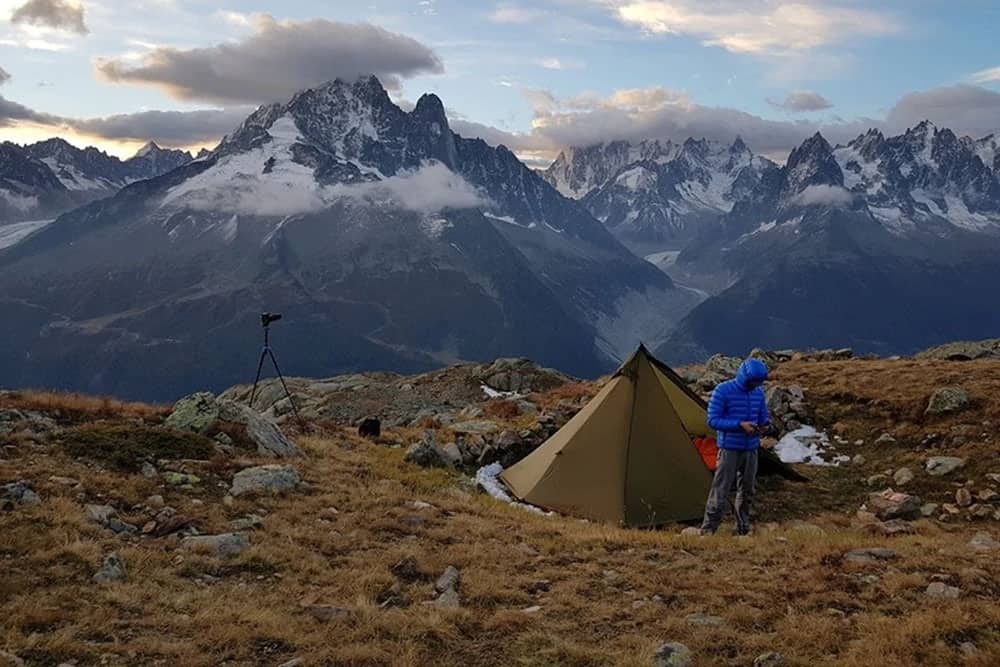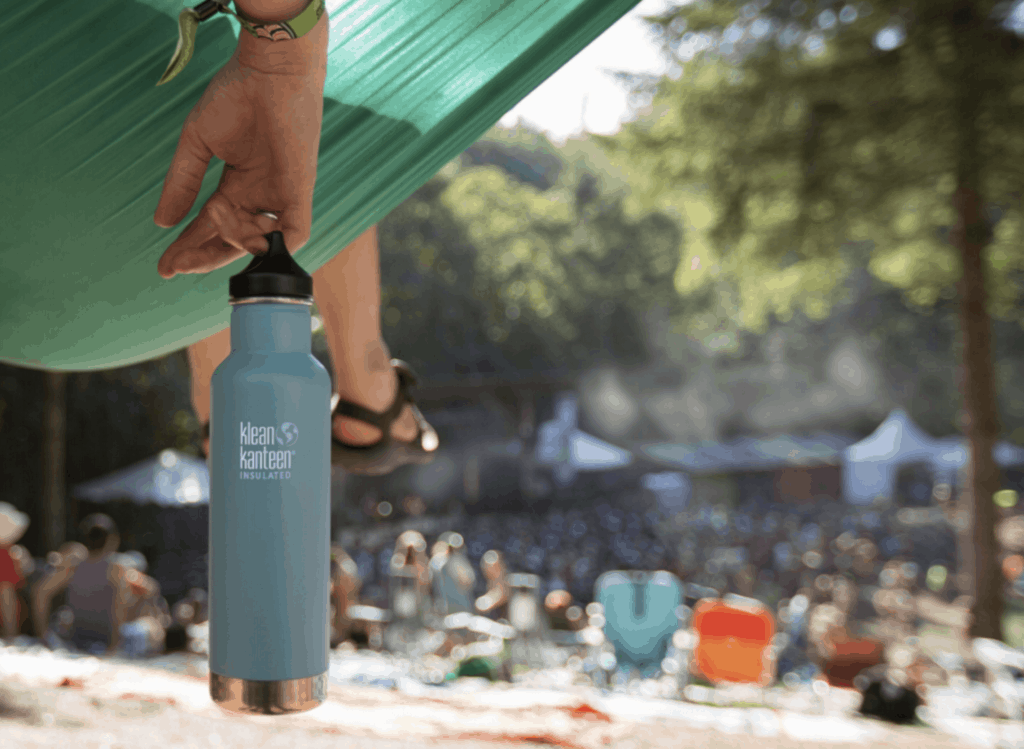When the cold weather hits, you will want only the best gear to keep you warm. You’ll need a variety of items including good gloves, a balaclava, long underwear and – perhaps most important of all – a good down jacket.
A good down jacket can be the difference between darting in and out of warm places and strolling along the street in comfort, enjoying the holiday atmosphere. It can also be the difference between enjoying your winter backpacking adventure and dying of hypothermia. So grab a cup of hot coffee and take a few minutes to peruse our list of the best down jackets.
1. Arc’teryx Cerium SL Hoody Men’s
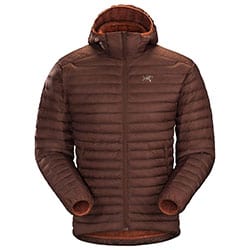
The handsome Cerium SL Hoody rides the line between ultra-light and middleweight. But however you want to classify it the jacket provides outstanding warmth down into the 20s Fahrenheit. And a bit beyond if you have the right undergarments. The Cerium SL is tailored more than your standard climbing jacket.
Which makes it more appropriate city wear than mountain wear. And that’s fine. City dwellers need to stay warm too. Overall, the Cerium is extremely comfortable, the hood is as effective as we could ask and the lined collar is very easy on your skin. The corded zipper pulls makes getting in and out with gloves on very easy. And the elasticized cuffs keep that north wind outside where it belongs.
2. RAB Neutrino Pro Jacket – Men’s

With 800 fill down, an integrated hood and a heavy duty shell the RAB Neutrino Pro is a serious down jacket that will appeal to mountaineers as well as city dwellers under siege from a Polar Vortex. The hydrophobic down employed here holds up to wet weather much better than standard down.
While the Pertex Quantum Pro (1) shell isn’t going to fail as a result of incidental contact with rocks and bushes. There are 8 ounces of that 800 fill down in play here. So this puppy will keep you plenty warm, even while standing around the campsite on bone-chilling days. It’s not cheap. But if you’re looking for the best down jacket for your next winter backpacking excursion any money you drop on the RAB Neutrino will be money well spent.
3. Outdoor Research Men’s Transcendent Down Jacket
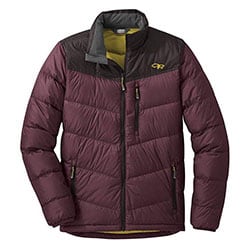
Not sure if this offering from Outdoor Research is actually ‘transcendent’ but it’s pretty close. OR makes a lot of very effective, durable down jackets and this is one of their best. The Transcendent is also a great value, standing its ground performance-wise against more expensive jackets issued by the competition.
With its tailored lines and hoodless design the Transcendent is more of an about-town jacket. Although you could conceivably wear it on late autumn hunting or backpacking excursions. It features 3.5 ounces of 650 fill down. That’s enough to keep most people comfortable down to around freezing. The Transcendent has 3 zippered pockets on the front and a warm, insulated neck that negates the need for a scarf.
4. Marmot Men’s Down Hoody Winter Jacket

The Marmot Men’s Down Hoody features 700 fill down that’s going to keep you warm in all but the most extreme conditions. Even then, with the right long underwear and a good wool sweater underneath it you’ll be toasty warm into the teens Fahrenheit. The shell is composed of 90% polyester and 10% elastane.
That provides it with a combination of toughness and flexibility that’s very appealing. There are several zippered pockets both inside and out along with adjustable Velcro cuffs to keep the cold air at bay. The jacket also features Marmot’s Angel-Wing Movement to guarantee a full range of motion. If there’s a weak link it’s the insulation in the hood. Not the best. Marmot makes one of the best down jackets on the market today.
5. Lapasa Men’s Packable Down Jacket
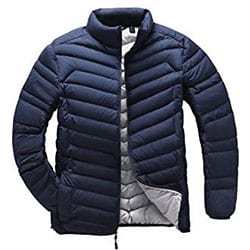
If you’re looking for a warm, stylish and affordable winter jacket for around town the Lapasa Packable Down Jacket is a good option. It features 600 fill white duck down that’s more than enough for average winter days. The 100% polyester shell is windproof and water resistant. While the cut is handsome and the distribution of insulation is both efficient and effective.
The jacket has elasticized cuffs that keep the cold air out and a chin guard to protect your chin/neck from catching in the zipper. It weighs about a pound and comes with a stuff sack. Though it’s hard to imagine anyone wanting to stuff this thing away between uses. It’s available in grey, black, navy and olive drab that’s anything but drab.
6. Tommy Hilfiger Men’s Packable Down Jacket
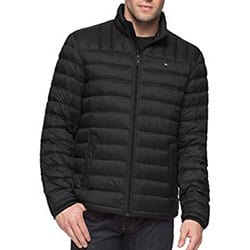
Hilfiger’s Packable Down Jacket is stylish, practical and surprisingly affordable. It’s strictly an around town down jacket and it serves that purpose well. It uses 90% duck down as fill and distributes it via a tight quilted pattern. Be aware though that this is not a jacket for extreme weather. Instead it’s intended for days or nights when the temperature is hovering in the 40s Fahrenheit.
Though you can push that lower limit with the right sweater underneath it. The jacket is hip length, the cuffs are elasticized and there are a pair of side pockets to keep your hands warm. This is another ‘packable’ jacket that comes with a stuff sack. But most guys are just going to hang it up when they’re not using it. Overall an excellent value.
7. Columbia Men’s Voodoo Falls 590

The Columbia Men’s Voodoo Falls 590 is a great everyday winter jacket that’s stylish and comfortable and comes in 9 different colors. It uses 550 fill down insulation which will keep the wearer nice and warm down to about 40 Fahrenheit. Lower if you’ve got a wind shell over it. At just over a pound the 590 is light.
But with its Omni-Heat Reflective technology is does a bang-up job making the most of every ounce of insulation. There are plenty of zippered pockets. Including one just inside the main zipper for your smartphone. While the water resistant shell won’t let you down if it starts to sprinkle. The hood is also a lot warmer than it looks at first glance and the zipper pulls are very glove-friendly.
8. The North Face Men’s Gotham Jacket III
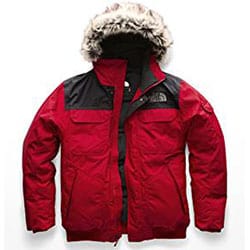
Before their logo began appearing on t-shirts and baseball caps, The North Face actually made some of the best winter climbing outerwear you could buy. They still do. Though to a more limited degree these days. Their North Face Gotham Jacket III is a good example of what they still get right. This is more than just a puffer jacket.
It’s a true outdoorsman’s winter coat that’s tough and warm and wind resistant. There are plenty of large external pockets for your snacks, maps, compass, sunglasses, lip balm and everything else. The shoulders are reinforced to accommodate your backpack shoulder straps and the hood zips up over your mouth if need be to provide protection from biting mountain winds. The fur trim on the hood is a curious addition, however. Fortunately, it can be easily removed.
9. Spyder Pelmo Down Jacket
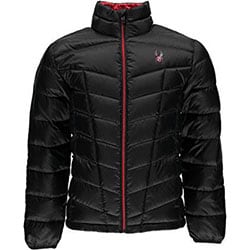
The Spyder Pelmo Down Jacket is warm, light, reasonably priced and cut to look good. Fortunately, it also lives up to its cold weather responsibilities. The shell is 100% polyester. The insulation is 550 fill power duck down that will keep you warm to around freezing.
That’s better performance than other 550 down jackets simply because Spyder gives you more of it than other manufacturers. So the jacket has a slightly puffy look. But it’s also cut in a way that keeps that puffiness effectively under control. One thing we love is that the Spyder can be thrown into the washing machine. Another is the microfiber neck lining that prevents chafing.
10. Carhartt Men’s Flannel Lined Duck Active Jacket
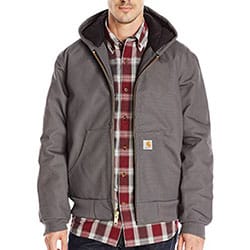
The last of our best down jackets comes to us from Carhartt. This is a great choice for guys who work outside in cold weather. Construction foremen, heavy equipment operators and more will find it provides outstanding wind resistance and durability.
By itself it’s not going to hold up south of 40 Fahrenheit. But with some good long underwear and a wool sweater underneath it really shines. Nice big utility pockets, ribbed cuffs and a drawstring hood complete the picture.
FAQs
Are There Different Categories of Down Jackets?
There are several different categories of down jacket. They are:
Ultra-Light Down Jackets
Ultra-light down jackets are typically used by day hikers, cross country skiers and fashion conscious city dwellers. They’re light alright. Compressible too. But they’re also very effective because of the type of high quality goose down (2) they employ. Just don’t mistake them for something you could wear ice fishing. Because, while they will keep you warm on cold days as long as you are active, (or not outside for extended periods of time), they’ll be overwhelmed if you’re not moving around, or if there’s a cold, biting wind.
Lightweight and Middleweight Down Jackets
There is often a lot of crossover between the lightweight and middleweight categories of down jackets, which is why it doesn’t really make sense to separate the two. These are warm and comfortable jackets that are more durable than ultra-light down jackets. Many of them also have either an integrated or detachable hood.
There’s quite a temperature range at work as you might imagine and this can be a source of some confusion. Because some lightweight jackets will keep you toasty warm well below freezing. While some marketed as middleweight jackets will require a sweater underneath to help out if the temp falls below about 40 Fahrenheit. In general though, the warmest of them are a step up in serious winter wear from the ultra-light. But they’re not going to be enough to summit Denali with.
Heavyweight Down Jackets
A heavyweight down jacket is going to provide a significant boost in the warmth department over a middleweight, lightweight or ultra-light down jacket. With a heavyweight jacket you’re good down to zero Fahrenheit (or at least close) in most cases.
Although it’s important that you verify the temperature rating of your coat before buying it. The heavyweight down jacket will be puffier than other jackets. But when it’s cold enough to freeze the snot dripping out of your nose you’re not going to care. If you’re going winter camping or ice fishing or your city is gripped by Ye Olde Polar Vortex (3) you’re going to need a heavyweight down jacket.
What to Look For in a Down Jacket?
There are actually quite a few things to consider when looking for the best down jacket.
- Warmth – This is first because it’s why you’re buying a down jacket to begin with. No other type of jacket provides the same degree of consistent warmth. However, whereas down sleeping bags have their own EN rating system (4) that tells you what you can expect, down jackets do not. Which is why you get situations like we touched on above where a jacket that’s marketed as ‘middleweight’ is outperformed by one marketed as ‘lightweight’. If you are unable to try on a jacket you’re interested in we’d recommend you read as many reviews as possible and see what the consensus is before laying down your hard-earned money.
- Weight – The other factor that separates down jackets from other types of cold weather coats is weight. The best down jackets are extremely light. And that can be particularly important if you are into winter hiking, skiing, ice fishing or hunting. We should mention though that the better the down the lighter it will be, but the more expensive as well. What you have to ask yourself is whether trimming half a pound is worth the extra $100+ you’re going to pay.
- Fit – Whether you’re wearing your down jacket to work, out on a date, up the ski slope or into the wild it will have to fit properly or it’s going to be a long day. Some down jackets fit more like pullovers than coats. They leave very little space between your underlayers and the jacket itself. They can also pinch in the underarms and shoulders. This is typically okay if you’re just trying to make a fashion statement. But it’s not going to cut it when you need to raise your 12 gauge quickly to get after waterfowl. North Face down jackets tend to provide plenty of room to maneuver, as do brands like Outdoor Research. The point is, consider the demands of the activity you have in mind before buying a down jacket.
- Compressibility – Lots of people get all hot and bothered about this issue. But frankly, unless you’re heading into the wild on an extended backpacking trip you don’t need to worry about compressibility. Sure, if you are spending a week in mid-January exploring the Presidential Range (5) there will be times you’ll want to remove your down jacket and stuff it in the pack. However, if you’ve spent $500 on an ultra-light down jacket from a big brand-name designer are you really going to take it off in that trendy bistro and cram it into a tiny stuff sack? Or cram it into that tiny stuff sack once you get home? Of course not. So make what you will of compressibility. But in our book this is a backpacker-only concern. And even then a fairly remote one.
- To Hood or Not to Hood? – That is the question. Like a lot of other considerations this one comes down to how you intend to use the jacket. If it’s strictly a way for you to add a little warmth to your fall outfits then the hood is probably a non-starter. If, however, you’re buying it because you just want to stay warm and style points be dammed, then by all means you should get one with a either a fixed or detachable hood. And it should go without saying that if you plan on hunting, ice fishing, or winter backpacking a hood is an absolute must.
- Fill Power – Fill power is the measure of the quality of the down (6). The higher the fill power number the better the down, the warmer the jacket. The term itself is a little vague though. A better term would probably be ‘loft’. Since that is essentially what fill power is measuring. The amount of space an ounce of the down in question takes up in a measuring tube. The more space it takes, the more loft it has and the more air it will trap. And, of course, it’s that trapped air that contains the heat (7), not the down itself. The down just creates the structure that traps the warm air.
- Fill Weight – Jackets using lower fill power down will need to use more down to keep you warm. The amount of down in your jacket is called the fill weight. So, if one jacket has 10 ounces of 800 fill down and another jacket has 8 ounces of 800 fill down, the jacket with the 10 ounces of fill will be warmer. Also, if you have 10 ounces of 800 fill in one jacket and 10 ounces of 600 fill in another, the 800 fill jacket will be warmer. Because 800 fill is warmer than 600 fill.
- Denier – The toughness and durability of synthetic shells is often measured in Denier (8). Which is why you’ll see jacket advertised as being 600D or 400D polyester or nylon. Denier actually measures the weight of the thread, with larger numbers denoting heavier thread. So, as a general rule, the heavier the thread the more durable the shell. The lighter the thread the less durable the shell. The shell fabric is important when it comes to providing protection from the wind, helping the down retain heat and preventing incidental contact from turning into big open gashes in your jacket.
- Hydrophobic Down – Down has always had one significant down side (so to speak). Once it gets wet it clumps together and loses its ability to retain heat. In the past few years though hydrophobic polymers (9) have been developed that can be added to the down, allowing it to retain its structure even when wet. And as long as the down can trap some air it will retain some heat. It’s not a perfect solution. And you’ll still find synthetic fills that will do a better job when wet. But it’s a pretty significant step in the right direction.
What About Synthetic Insulation?
We just mentioned synthetic insulations and we’d be remiss if we didn’t touch on the subject before we closed. If only because they’ve become so popular in recent years. The long and the short of it is that high-quality synthetic fills will do a better job retaining heat when wet. They are typically more breathable than down too. And that can come into play when the sun is shining and you’re heating up. They’re also cheaper across the board.
Those are all positive things to be sure. But the fact is they are still no match warmth-wise for a good down jacket. And it’s not even very close. So if you’re worried about getting caught in the rain in your jacket, then you should consider synthetics. Same if you’re on a budget. But if the point is to stay warm, then you should go with down if you can swing it financially.
The Bottom Line
The down jacket hasn’t really changed all that much since Eddie Bauer created the first one back in the late 1930s (10). The main difference now is that there are so many different makes and models on the market that it’s hard to separate the wheat from the chaff. But if you keep the above information in mind when shopping for your next down jacket you’re bound to find one that fits your particular needs to a T.
